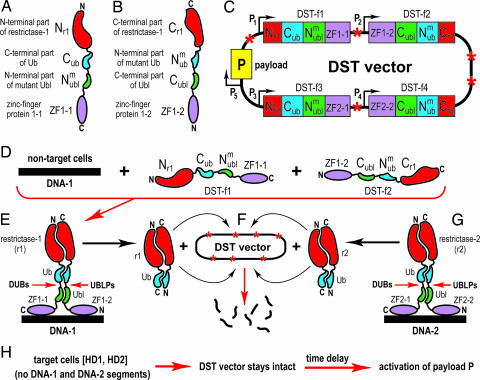Fig. 2.
DST devices and their implementation. See DST Circuit and Its Operation for descriptions of specific components and circuits shown. (A) DST-fusion-1 (DST-f1). (B) DST-f2 fusion. (C) The ORFs of DST vector, which contains at least five ORFs. The ORF(s) encoding “payload” P (e.g., a conditionally toxic protein) is in yellow. See item 11 in the main text for a description of payload's design and induction. (D) DST vector enters normal (nontarget) cells, which contain either one or both of DNA segments, DNA-1 and DNA-2, that are absent in target cells, owing to the homozygous deletions HD1 and HD2. Only DNA-1 and its ligands DST-f1 and DST-f2 are shown in D. The other pair of DST fusions, which recognize DNA-2, is shown in G. (E) The operation of DST circuit in a normal (nontarget) cell, which is depicted, without loss of generality, to contain both DNA-1 and DNA-2. It may also contain just one of two DNA segments. DUB, deubiquitylating enzyme; UBLP, Ubl-specific protease. (F) Conditional destruction of DST vector. The released r1 nuclease becomes free to target its cleavage sites in DST vector, digesting it to small fragments and thereby halting the expression of its ORFs, including the (possibility of) expression of vector's payload P. Note that payload's expression had not been induced as yet at this stage. (G) If both DNA-1 and DNA-2 are present in a non-target cell, as shown here, an otherwise identical liberation of the reconstituted nuclease r2 takes place as well. (H) Events in a target cell, i.e., the one that contains both HD-1 and HD-2, and had received DST vector. Because neither DNA-1 nor DNA-2 are present in such cells, the reconstitution of r1 or r2 (which require the binding of ZF domains to DNA-1 or DNA-2) does not take place, and the DST vector stays intact. After an empirically optimized time delay, to allow DST circuits to search for DNA-1 and/or DNA-2, the vector's payload P (e.g., a cytotoxic protein) can be activated.

